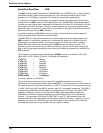
146
DataTalker Owner’s Manual
BSC (Binary Synchronous Communications): Also called "bisync", this communications protocol was the first synchronous data
format used by IBM. It is still in use, but is rapidly being replaced by IBM's newer Synchronous Data Link Control (SDLC). Bisync is a
byte-synchronous protocol that has longer delays and more overhead than the bit-synchronous SDLC. It uses two synchronization
characters to head every packet.
Bit (Binary digIT): A bit is the basis of the binary number system. It can take the value of 1 or 0. Bits are generally recognized as the
electrical charge generated or stored by a computer that represent some portion of usable information.
Bit-synchronous transmission: A synchronous form of data transmission that focuses on a maximum packet size rather than the
length of the characters the packet contains. SDLC is a bit-synchronous protocol.
Boot: To start or restart your PC. This term originates from the saying " to pull oneself up by the bootstraps".
Bps (bits per second): A unit to measure the speed at which data bits can be transmitted or received. Bps differs from baud when
more than one bit is represented by a single cycle of the carrier.
Buffer: A temporary storage register or Random Access Memory (RAM) used in all aspects of data communications which prevents
data from being lost due to differences in transmission speed. Keyboards, serial ports, muxes and printers are a few examples of the
devices that contain buffers. A buffer allows one device to dump data at a high speed and for the lower-speed device to accept it at its
own pace. In this way , the high-speed device can continue its work without having to wait for its data transfer to end. Buffers are a way
of preventing potential data loss.
Bus: A common channel between hardware devices either internally between components in a computer, or externally between stations
in a communications network.
Byte: The unit of information a computer can handle at one time. The most common understanding is that a byte consists of 8 binary
digits (bits), because that's what computers (PCS) can handle. A byte holds the equivalent of a single character (such as the letter A).
C
Capacitor: An electronic device that stores an electrical charge. It comes in varying sizes for use in anything from power supplies to
the tiny cells in dynamic RAM chips. When the device is powered down, it's capacitors lose their charge.
Carrier signal: An analog signal with known frequency, amplitude and phase characteristics used as a transport facility for useful
information. By knowing the original characteristics, a receiver can interpret any changes as modulations, and thereby recover the
information.
CCITT (Consultative Committee for International Telephone and Telegraph): An advisory committee created and controlled by the
United Nations and headquartered in Geneva whose purpose is to develop and to publish recommendations for worldwide standardiza-
tion of telecommunications devices. Now known as the International Telecommunications Union (ITU-T), CCITT has developed modem
standards that are adapted primarily by PTT (post, telephone and telegraph) organizations that operate telephone networks of countries
outside of the U.S.
Character set: One of a number of coding schemes which uses binary digits to represent characters, numbers, punctuation, and/or
control characters. Common character sets are ASCII, ANSI or EBCDIC.
Checksum: A control field found in synchronous data packets which contain the results of the error control algorithm used.
Chip: Also called integrated circuits (IC), they are squares or rectangles that contain from a few dozen to a few million electronic
components.
Circuit: Any closed path through which electrical current can flow.
Circuit-switched Network: A technology used by the PSTN that allocates a pair of conductors for the exclusive use of one communica-
tion path. Circuit switching allows multiple conversations on one talk path only if the end-users multiplex the signals prior to transmis-
sion.
Circuit switching: The temporary connection of two or more communications channels using a fixed, non-shareable path through the
network. Users have full use of the circuit until the connection is terminated.
Clock: A timing signal generated by an oscillating circuit which is used to synchronize data transmissions.
Command: An instruction that tells a computer to begin, continue or end a specific operation.
Command mode: One of two states of an intelligent (i.e. programmable) device. The mode in which commands can be issued to alter
operating parameters.
CRC (Cyclic Redundancy Check): A field used in packetized data that contains two 8-bit BCCs ( Block Check Characters) as the
binary result of an algorithm performed on the data bits in the packet. A CRC is used for error detection by many synchronous protocols.
CTS (Clear To Send signal): With communications between modems, an RS-232 signal sent from the modem to the DTE that
indicates it is ready to accept data. Contrast with RTS.
D
DC (Direct Current): This is usually understood to mean a constant voltage supply that fluctuates only a nominal amount. An analog or
digital signal that may vary in voltage level, but it never crosses the reference voltage (usually called ground). Contrast with AC.


















